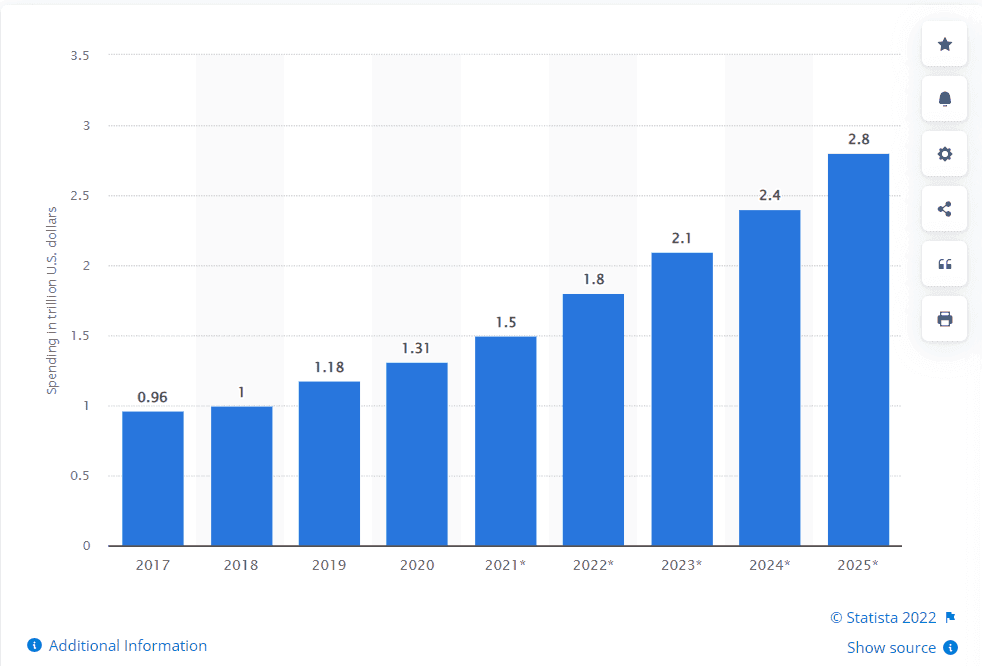Digital transformation is no longer a buzzword or a smart plan to have. It is now an absolute necessity for the sustainability of every business. Pandemic, affected business operations around the world which led many organizations to embrace digital transformation as a critical step in preserving their operations. This is observed in the most recent digital transformation data.
Digital Transformation today plays a crucial role in increasing business value. Here are some stats about its impact :

89% of all companies have already adopted a digital-first business strategy or plan to do so. (IDG)
70% of companies either have a digital transformation strategy in place or are working on one. (Tech Pro Research)
In 2022, spending on digital transformation (DX) is projected to reach 1.8 trillion U.S. dollars. By 2025, global digital transformation spending is forecast to reach 2.8 trillion U.S. dollars. (Statista)
Let’s find out more about Digital Transformation and its key components :
What Is Digital Transformation?
The process of leveraging technology and strategies to build new or improve existing business processes, culture, and customer experiences in order to meet changing business and market requirements is known as digital transformation. Digital transformation is a reinvention of business in the digital age.
Let’s Discuss The 6 Key Components Of Digital Transformation-
Crafting a successful digital transformation strategy demands expertise, competence, and a willingness to revolutionize traditional business practices. As a result, there are various components to consider when developing a strategy. Among them these 5 key components are the most important. Let’s have a look.
People Transformation
Digital transformation starts with people before you even think about technology implementation, because it demands the right mindset, adoptability and talent to implement and drive the show. It will require alignment at all levels of your organization, as well as cross-departmental and cross-business unit communication.
Transformation in Processes
You have to think beyond the traditional way of processes. It does not mean performing seamless communication using emails and telephone. It is all about implementing technology that will initiate new and improved processes for better business growth. Start identifying and fine-tuning your digital workflow. Conducting in-depth customer journey mapping and identify the possible touch points and find out ways or solutions to automate and personalize it.
Data Driven
Data plays a critical role in digital transformation when you are looking to scale your business or to tackle complex and unpredictable situations. Data involves in key interactions and discussions with employees, customers, and clients. You can use data to create digital records for different groups of people commonly known as Digitization. Technology is always at the forefront in the case of digitizing data. Data is the backbone of your all strategies, campaigns and decisions. More you invest in smart ways to capture it and have smart analytics, more you will effectively progress in digital transformation implementation and enjoy its amazing results.
Customer First
“Focusing on the customer makes a company more resilient.” – Jeff Bezos.
Businesses are now now investing in tools to obtain a detailed understanding of specific geographies and market categories. Looking at social media to see what makes customers happy and what causes them to be unhappy. Companies are learning how to use digital media to improve their brands more effectively. Many firms are enhancing their analytics capabilities in order to gain a better understanding of their customers. Others are doing tests to alter product prices dynamically based on demand and customer behavior.
Businesses with several customer touch points are under constant pressure to provide an integrated experience. Hence, organizations are focused on Omnichannel experience and are investing in integrated tools to manage it. The Key factor of omnichannel experience, is the deep understanding of customer journeys and its possible touch points and success of its implementation is measured by personalized and uniform experiences in channels.
Technology Investment
One of the most important aspects in developing a digital transformation strategy is identifying appropriate technology for your company. Incorporating technology into your business will necessitate a significant financial investment. As a result, it must be done appropriately to eliminate the need for further expenses. The following are some of the most cutting-edge technologies that should be part of your digital transformation strategy:
- Cloud and Distributed Platforms
- Data Analytics and Artificial Intelligence
- Experience Design and UI/UX
- Marketing automation and integrated platform
Overall Impact/Results
You can evaluate the overall impact or end results based on the actions that have been performed. You can go back to data and change the way you design your strategy once the overall impact is evaluated. The results can be used to iterate and improve. This means that your team is always evolving and getting better with time. Overall results can help to bridge the gap between human and technology trends.
To Sum up Things
The world has changed drastically due to ever-changing technology trends, and digital transformation is an aspect that cannot happen overnight. This requires a shift in the mindset, culture, and talent. This means that the workforce should be ready to upskill themselves to be better prepared for future trends. It is time to prepare your teams and organizations for a better future ahead.

